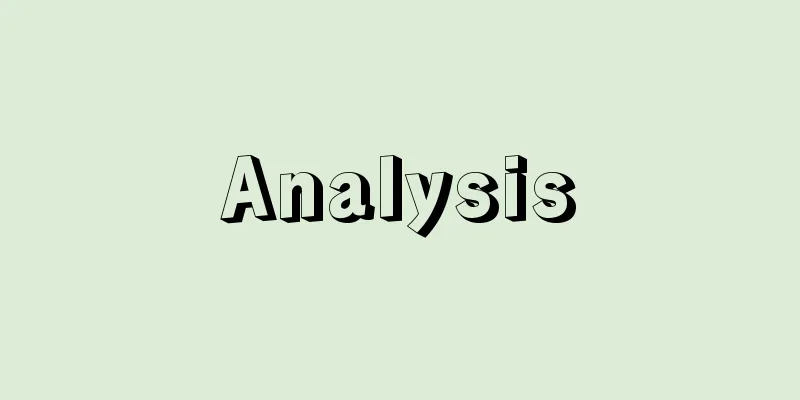Analysis

|
One of the major branches of mathematics, along with algebra and geometry. It is based on the concept of limits. It is a general term for series theory, differential and integral calculus, complex function theory, Fourier analysis, functional analysis, differential equation theory, integral equation theory, and the calculus of variations. [Osamu Takenouchi] From the Greek period to the 17th century The concept of limits dates back to Eudoxus around 400 BC. Euclid's Stoikeia (The Elements of Euclid) calculates the volume of a cone and a pyramid, which was due to Eudoxus. Later, around 250 BC, Archimedes gave the area of a parabola and one of its chords, the surface area and volume of a sphere, and so on. These Greek mathematicians created a sequence that approximated the quantity S to prove that the quantity S was a certain value A. Using this, they proved that |S-A| must be zero because it is smaller than any term in a sequence that converges to zero. This is called the "method of exhaustion." The argument was geometric and extremely rigorous, but for a while afterwards, there was no research that could be developed further, and new developments in analysis had to wait until the 17th century. However, the French mathematician Nicole Oresme (1330-82) In the early 17th century, Galileo calculated the center of gravity and moment of inertia of various figures, and the Italian Cavalieri devised the Cavalieri principle, which considers figures to be made of line segments and thin plates, to calculate the area and volume of figures. Pascal's area calculation method is based on a similar idea and methodology. In the first half of the 17th century, the British Napier and the Swiss Bürgi discovered logarithms, which, along with the trigonometric functions that were known up to that point, had a great influence on the formation of the concept of functions. The founding of analytical geometry by Descartes, which links figures and equations, was crucial in the birth of differential and integral calculus. In fact, Fermat and the British Barrow used this connection to study how to draw tangents to curves. The Belgian Gregorius Saint Vincent (1584-1667) discovered that the area under the hyperbola y = 1/x has logarithmic properties. [Osamu Takenouchi] Late 17th century to 18th centuryIn the late 17th century, Newton discovered calculus in 1665, and Leibniz discovered it in 1675. It seems that Newton's discovery was only communicated in an incomplete form to mathematicians close to him, and Leibniz published his research entirely independently. In 1667, Newton wrote to Leibniz twice, and their replies exchanged information about each other's research. At this time, expanding functions became a topic of great interest. In 1665, Newton discovered the general binomial theorem, in 1668, Nicolaus Mercator (1619-1687) discovered the series expansion of log(1+x), and in 1669, Newton discovered the series of sin x and cos x . Leibniz's formula The man who stood tall in the 18th century was Euler. In his Introduction to Infinitesimal Analysis (1748), he developed the first systematic description of analysis. He introduced the base e of the natural logarithm, and Euler's formula e ix =cos x + i sin x [Osamu Takenouchi] After the 19th centuryThe 19th century was a time when analysis was reexamined and its foundations were established. The theory of real numbers took its modern form in the second half of the 19th century, after the work of Weierstrass, Dedekind, Cantor, and others, but Cauchy had already clearly stated the so-called Cauchy criterion in his "Les analytices" (1822). This was a proposition sufficient to define real numbers axiomatically. Cauchy also tried to clarify the definition of integrals, but failed, which is attributed to Riemann. Cauchy further extended differential and integral calculus to the case of complex variables, forming the basis of the theory of complex functions. This was developed into the theory of analytic functions by Weierstrass. The theory of elliptic functions by Gauss and Jacobi also had a great influence on mathematics in general thereafter. Meanwhile, in his Analytical Theory of Heat (1811), Fourier discussed expanding functions into Fourier series or expressing them as Fourier integrals and using them. This did not constitute a mathematical theory in its own right, but it was later established by Dirichlet and others, and has become an important tool in modern analysis. Later, in the 1870s, Cantor's discussion of topological spaces was also incorporated into analysis. Then, in the early 20th century, Fredholm and Hilbert's theory of integral equations was abstractly developed into the theory of Hilbert spaces, which, with the birth of quantum mechanics, provided an important tool in physics as well. The theory of Hilbert spaces was widely developed into functional analysis, giving rise to the characteristic form of analysis today. [Osamu Takenouchi] "History of Mathematics 5: Mathematics in the 18th Century" by Ken Kobori (1979, Kyoritsu Shuppan) [References] | | | |Source: Shogakukan Encyclopedia Nipponica About Encyclopedia Nipponica Information | Legend |
|
代数学、幾何学と並んで、数学を大きく分けたときの一つの分野。極限概念を基礎とする。級数論、微分積分法、複素関数論、フーリエ解析、関数解析、微分方程式論、積分方程式論、変分法などの総称。 [竹之内脩] ギリシア時代から17世紀まで極限概念のおこりは古く、紀元前400年ごろのエウドクソスにまでさかのぼる。ユークリッドの『原本』(ストイケイア)で、円錐(えんすい)、角錐の体積を求めているが、これはエウドクソスによるものである。その後、アルキメデスは前250年ごろ、放物線とその一つの弦で囲まれた部分の面積、球の表面積、体積などを与えている。これらギリシアの数学者は、求める量Sがある値Aであることを証明するために、量Sを近似する列をつくった。それを用いて、|S-A|がゼロに収束するようなある数列のどの項よりも小さいから、ゼロでなければならないとした。これは、「取りつくし法」とよばれている。その議論は幾何学的で、まことに厳格なものだったが、以後しばらくはその研究を発展させることのできるものがなく、解析学の新たな展開は17世紀まで待たなければならなかった。もっとも、フランスのオレームNicole Oresme(1330―82)は、 17世紀初め、ガリレイは、いろいろな図形の重心や慣性モーメントを計算し、またイタリアのカバリエリは、図形が線分や薄板でできていると考えてカバリエリの原理を案出し、図形の面積や体積を求めている。パスカルの求積法も同じような考え方、方法論によっている。17世紀前半には、イギリスのネーピアや、スイスのビュルギによる対数の発見があり、それまでに知られていた三角関数などとともに、関数概念を形成していくうえで大きな影響があった。デカルトによって図形と式を結び付ける解析幾何学が創始されたことは、微分積分学が誕生するうえで決定的な意味をもつものであった。実際、フェルマーやイギリスのバローは、この結び付きをもとに、曲線に接線を引く方法を研究した。ベルギーのサン・バンサンGregorius Saint Vincent(1584―1667)は、双曲線y=1/xの下の面積が、対数の性質をもつことを発見している。 [竹之内脩] 17世紀後半~18世紀17世紀後半の1665年にニュートンが、1675年にはライプニッツが微分積分法を発見した。ニュートンのこの発見は、不十分な形で近辺の数学者にのみ伝えられていたようで、ライプニッツはまったく独自に自分の研究を発表したのである。1667年に二度にわたってニュートンからライプニッツにあてた手紙、およびその返書により、お互いの研究が交換された。 このころは、関数を展開することが大きな関心の対象となった。1665年にニュートンが一般の二項定理を、1668年にメルカトルNicolaus Mercator(1619―1687)がlog(1+x)の級数展開を、1669年にニュートンがsinx、cosxの級数をみいだしている。ライプニッツの公式 18世紀に高くそびえるのはオイラーである。『無限小解析入門』(1748)において、系統的な解析学の叙述が初めて展開された。自然対数の底(てい)eの導入、そしてオイラーの公式 [竹之内脩] 19世紀以後19世紀は、解析学の足元を見直し、その明確な基礎をつくっていった時代であった。実数の理論が現代的な形をとるのは、19世紀後半、ワイアシュトラース、デーデキント、カントルらの研究のあとのことであるが、コーシーはすでにその『解析教程』(1822)において、いわゆるコーシーの判定条件を明記している。これは実数を公理的に定義するのに十分な命題であった。コーシーはまた積分の定義を明確にしようとしたが果たせず、それはリーマンに帰せられることになる。コーシーはさらに、微分積分法を複素変数の場合にまで進め、複素関数論の基礎をつくった。これは、ワイアシュトラースによって解析関数の理論へと発展した。また、ガウス、ヤコービによる楕円(だえん)関数論も、その後の数学全般に与えた影響は大きい。 一方フーリエは『熱の解析的理論』(1811)において、関数をフーリエ級数に展開し、あるいはフーリエ積分で表現し、それを活用することを論じた。これは、そのままでは数学的理論になっていなかったが、のちにディリクレらによって基礎づけられ、現在の解析学の重要な手段となっている。下って1870年代、カントルが始めた位相空間の議論は、解析学のなかにも取り入れられた。そして、20世紀初頭のフレドホルムやヒルベルトの積分方程式論は、抽象的に発展してヒルベルト空間の理論となり、量子力学の誕生とともに、物理学にも重要な手段を提供することになった。ヒルベルト空間の理論は、広く発展して関数解析となり、今日の解析学の特徴ある姿をつくっている。 [竹之内脩] 『小堀憲著『数学の歴史5 18世紀の数学』(1979・共立出版)』 [参照項目] | | | |出典 小学館 日本大百科全書(ニッポニカ)日本大百科全書(ニッポニカ)について 情報 | 凡例 |
Recommend
Usuya
...There is a high coastal terrace on the coast, ...
Inner marker - Inner marker
…(3) A marker beacon (also simply called a marker...
Helminthostachys zeylanica (English spelling) Helminthostachyszeylanica
...Although it is not particularly used, the dwar...
Daendels, Herman Willem
Born: October 21, 1762. Hattem [Died] May 2, 1818....
University of Naples (English name)
It was founded in 1224 by Holy Roman Emperor Frede...
Magnetomotive force
The quantity of magnetism corresponding to the ele...
Gross Profit
・Gross profit・Gross profit = Sales revenue - Cost ...
Penetrating
[1][1] In the Ritsuryo system, something recorded ...
Acer aidzuense (English)
… [Ken Ogata]. . … *Some of the terminology that ...
Devil stinger
A fish of the family Inimiidae. Generally speaking...
Iwai Rebellion
The rebellion of Tsukushi no Kimi (Kuni no Miyats...
Anorthite - anorthite
Anorthite is one of the six types of plagioclase,...
Wire glass - Amiiri glass (English spelling) wire glass
Plate glass sandwiched between metal mesh or wire ...
Canker sores - Canker sores
① An insect that is said to cause childhood jiro (...
Kinubari (silk-covered) - Kinubari (English spelling) serpentine goby
A marine fish of the Gobiidae family in the order ...









